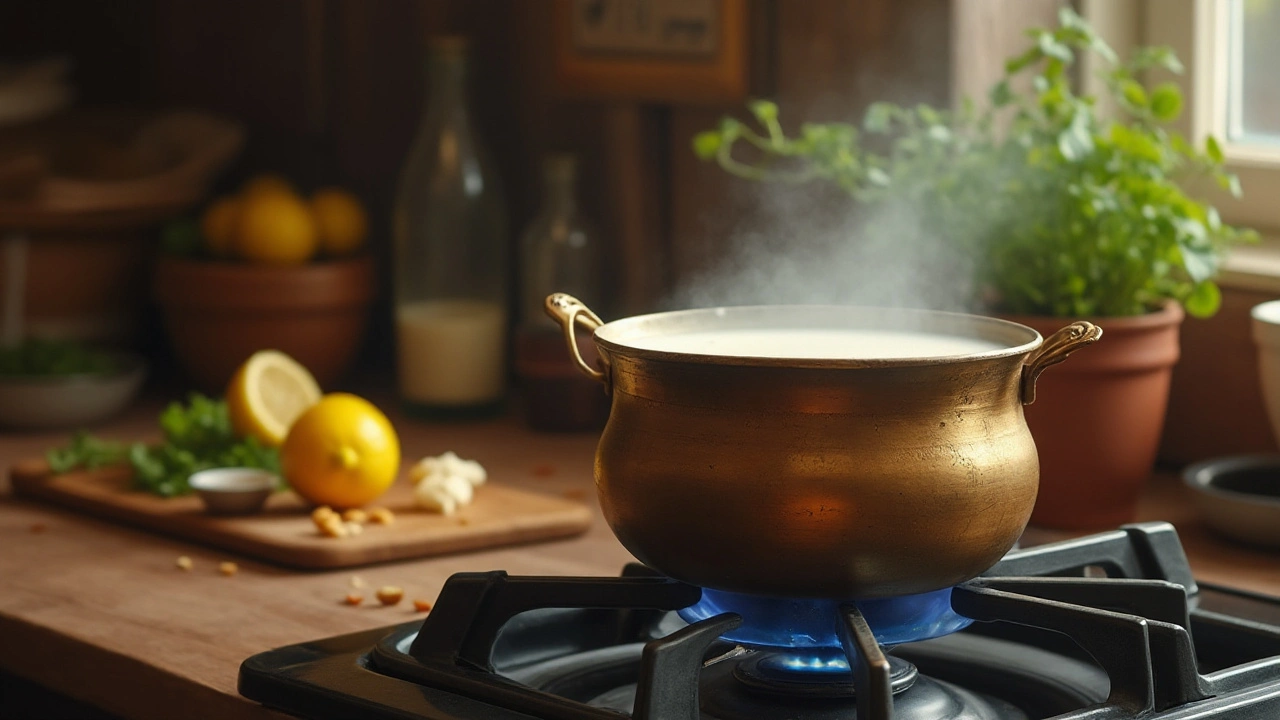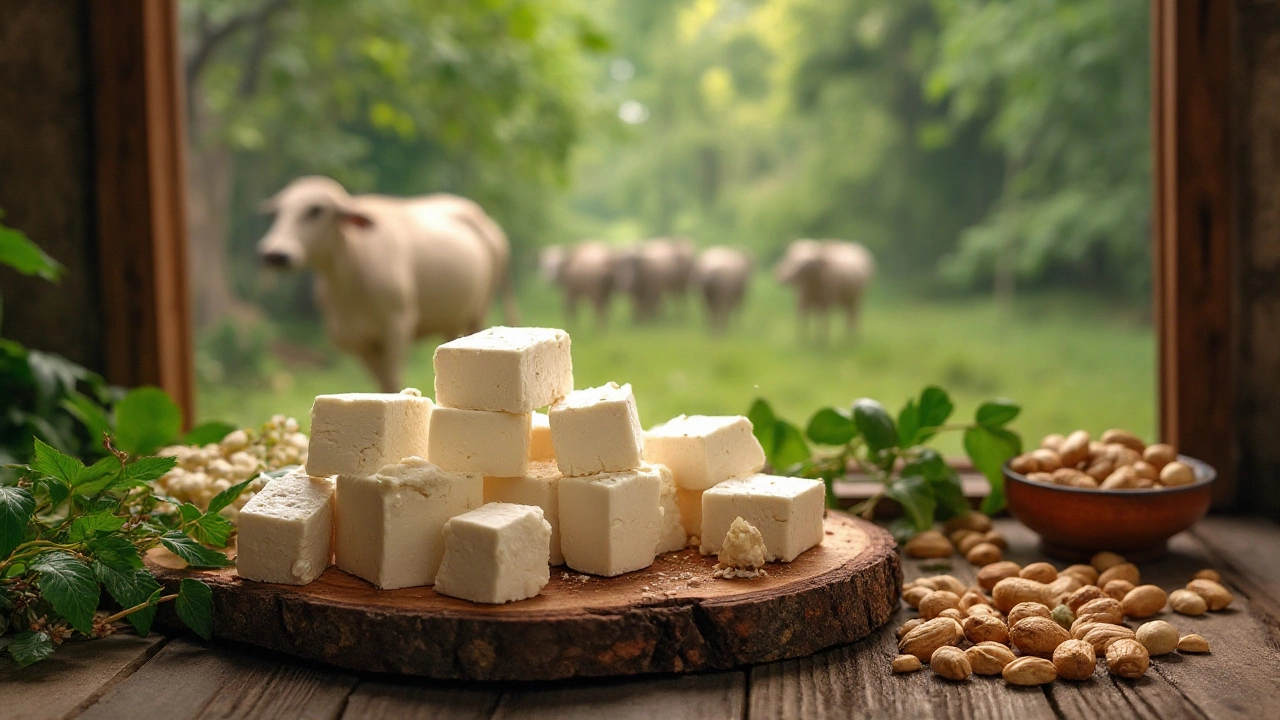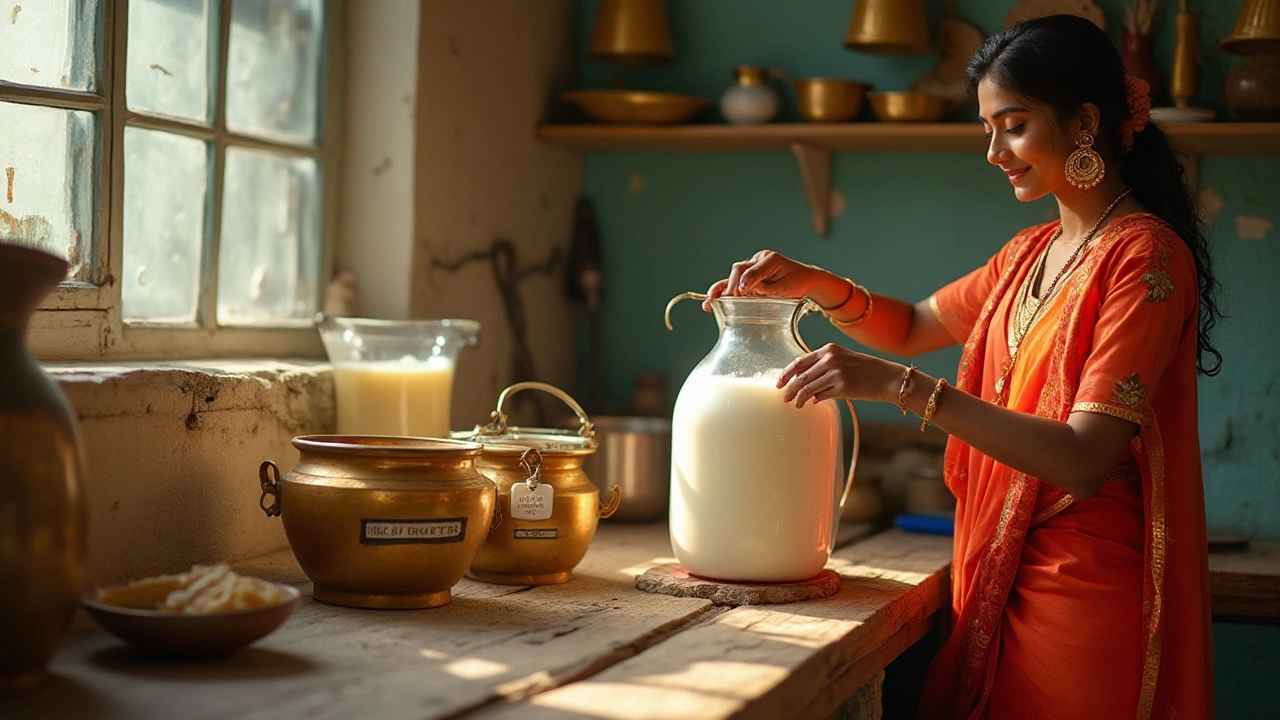21 Jan 2025
- 0 Comments
For ages, paneer has been a staple in numerous kitchens, adding its creamy presence to savory dishes and enriching meals with its mild yet distinct flavor. As more people embark on the journey of crafting homemade paneer, the question of which milk to use often arises.
Not all milk is created equal when it comes to paneer. Some deliver a creamier texture, while others may offer a firmer bite. Venturing into the world of milk choices, from the common varieties like cow and buffalo milk to plant-based options, can make all the difference in your paneer-making adventure.
This guide will walk you through the various milk options, highlight key factors to consider, and provide handy tips to transform your culinary efforts into delicious, fluffy pillows of paneer.
- Understanding Paneer and Its Uses
- Types of Milk for Paneer
- Choosing the Right Milk
- Special Tips for Making Perfect Paneer
- Flavor and Texture Considerations
Understanding Paneer and Its Uses
Paneer, a beloved dairy product, often finds its way into numerous kitchens across the globe due to its versatility and rich cultural heritage. In India, where paneer originated, it is a key ingredient in many traditional dishes, revered for its simple yet satisfying taste and texture. Unlike cheeses that undergo a fermentation or aging process, paneer is a fresh cheese, made by curdling milk for paneer using a souring agent, such as lemon juice or vinegar. The curds are then drained and pressed to form a dense, non-melting cheese that holds its shape even when heated. Due to its neutral flavor, paneer acts as a blank canvas, absorbing spices and sauces, making it a dynamic addition to both sweet and savory dishes.
In the culinary world, paneer is celebrated for its ability to complement an array of flavors and cuisines. From classic Indian dishes like palak paneer, where it soaks up the lush flavors of spinach and spices, to international adaptations such as paneer tikka, where it is marinated and grilled to perfection, paneer continues to delight palates everywhere. The texture of paneer, which can range from soft to firm, is highly dependent on the type of milk for paneer used in its production. Rich, creamy milk results in softer paneer, while milk with lower fat content yields a firmer texture. By understanding these characteristics, culinary enthusiasts can tailor their homemade paneer to suit their specific tastes and recipes.
"Paneer is a unique cheese that transcends culture and cuisine, by adding subtle richness and texture to a variety of dishes." - Gourmet Enthusiast Magazine
In its raw form, paneer can be enjoyed as is, often sprinkled with herbs or spices for additional flavor. Its firm nature allows it to be skewered and grilled, or cubed and tossed into curries and stews without losing its shape. Beyond these traditional uses, paneer has seen a surge in popularity as a meat substitute in vegetarian and vegan dishes. It provides a wholesome source of protein, making it a suitable alternative for those seeking to reduce meat consumption. The versatility and adaptability of paneer have made it an essential component in the realm of plant-based diets, and its appeal extends well beyond those following vegetarian lifestyles.
A look at the nutrition profile of paneer reveals that it's not only a culinary delight but also a healthy addition to any diet. Paneer is high in protein and calcium, while being low in carbohydrates, aligning well with ketogenic and low-carb diets. Incorporating paneer into your meals can improve bone health, aid in muscle development, and contribute essential nutrients to your body. To ensure you get the maximum benefit from your paneer, selecting the right milk for paneer is crucial, a topic we will delve into further as we explore the different types of milk available.
Consuming Paneer in Various Diets
Paneer's nutritional benefits aren't just confined to traditional diets; they extend to modern nutritional paradigms as well. Its high protein content supports muscle growth and repair, making it a staple in high-protein diets often adhered to by athletes and bodybuilders. The relatively low lactose content also means that many people who are lactose intolerant can still enjoy paneer in moderation without adverse effects. For those embracing low-fat dietary patterns, the ability to make paneer from skim or low-fat milk is an attractive option, offering the beloved taste without compromising nutritional goals. Whether for traditional meals or as part of a new dietary regimen, paneer stands out as an ingredient that marries flavor, versatility, and nutrition seamlessly.
Types of Milk for Paneer
When it comes to choosing the ideal milk for making paneer, the options are as diverse as the dishes you can create. Traditionally, cow's milk is the most readily available and widely used for paneer in many households. Its balanced fat content and availability make it a convenient contender for homemade paneer, providing a soft and fluffy texture. Cow's milk generally results in a mild taste, letting the other flavors in your dish shine through. A significant advantage of using cow milk is its ability to react well with the acid used to curdle it, forming those perfect solids that make paneer so special.
On the other hand, buffalo milk is preferred in regions where it is more commonly available. It's known for having a higher fat content compared to cow's milk, producing a richer and creamier paneer. The added fat gives the paneer a denser texture and makes it ideal for grilling or frying. Some paneer enthusiasts assert that buffalo milk paneer holds its shape better under heat, making it a popular choice for dishes requiring robust chunks. However, because buffalo milk is not as widely accessible everywhere, it might be a bit harder to come by in some locations.
In recent times, many people have been experimenting with plant-based milk alternatives like almond, soy, and oat milk to create dairy-free paneer. While these might not perfectly mimic the texture and taste of traditional paneer, they provide a viable option for vegans and those with dairy allergies. Plant-based milk typically requires additional stabilizers or thickeners to achieve the coagulation which is naturally achieved by animal milk's proteins. It's an exciting frontier in culinary experimentation, and some innovative recipes are emerging from this trend.
"Choosing the right milk for your paneer isn't just about tradition; it reflects our innovative spirit, letting us explore rich textures and flavors," says culinary expert Dr. Nandini Sharma.
Interestingly, there's also a budding interest in using goat's milk for paneer making. Known for a distinct taste that stands out, goat's milk can lead to paneer with a unique flavor profile, slightly tangier than its cow or buffalo counterparts. This can add an exotic touch to your dishes, provided you're willing to experiment. Issues like availability and often higher cost can make goat milk a less frequent choice but certainly one that adds excitement to the paneer-making narrative.
The world of milk for paneer is as expansive as it is rich with possibilities. Each type of milk contributes its own set of attributes to the final product—some offering creaminess, some providing firmness, and others gifting a unique flavor. Understanding these differences is the first step in perfecting your homemade paneer.

Choosing the Right Milk
When making your own paneer at home, selecting the right milk is a pivotal decision, intricately tied to the final taste and texture of the product. Start by considering the purity and freshness of the milk. Organic or raw milks, although pricier, typically offer a more authentic experience with fewer additives, leading to a purer flavor profile in your homemade delicacy. The fat content in milk plays a critical role too. Higher fat milks often result in richer, creamier paneer, while lower fat options might make it crumbly. For many, cow’s milk is the go-to choice thanks to its availability and balanced fat content. Yet, buffalo milk, with its higher fat and creaminess, is beloved for paneer in many parts of the world.
On the other hand, if you'd like to explore alternatives to traditional dairy, plant-based milks now present an evolving frontier. Soy and almond milk can serve as a base, though achieving the traditional paneer texture can be challenging. It's recommended to conduct small batches and experiment with coagulants like lemon juice or vinegar, adjusting quantities as you go. The key is to expect some variation and find what closest aligns to your palate. A veteran home cook once shared, "Buffalo milk yields paneer as rich as I remember from Indian weddings,"
- Renowned food blogger Samin Nosrat, attesting to the creamy allure of buffalo milk for those seeking opulence.
Let's also remember the invaluable attributes each type brings. Cow’s milk results in a lighter and more delicate paneer, suitable for recipes calling for a soft bite. This distinct advantage makes it especially favorable when cooking dishes that require paneer to absorb sauces or spices. Meanwhile, buffalo milk stands its ground and holds its form, making it excellent for grilling or stir-frying, where the cheese must maintain integrity. In this regard, exploring multiple sources of milk can unlock an infinity of culinary possibilities, allowing cooks to match different types of paneer to their specific dishes or preferences.
A brief look at how these milks perform might inspire further curiosity.
| Milk Type | Fat Content | Paneer Texture |
|---|---|---|
| Cow’s Milk | 3.25% | Light and Soft |
| Buffalo Milk | 6.7% | Rich and Firm |
| Soy Milk | 2% | Varies, Soft-Silken |
Experimentation with milk types can lead to pleasant surprises. Many households also blend different milks for unique flavors and consistency, making the most of what's stocked at home. As much as we thrive on traditional recipes, there exists a modern push towards crafting something distinctive and personal. Always remember, the journey you embark on with your paneer is rich in tradition yet open to innovation. Finding the right milk for yourself and your family can become a deliciously rewarding journey.
Special Tips for Making Perfect Paneer
Creating the perfect homemade paneer is as much an art as it is a science, but with a few tips up your sleeve, you'll be kneading soft and supple paneer in no time. The journey begins with the right milk. Always go for fresh, full-fat milk; it's the fat content that lends paneer its quintessential creaminess. Pasteurized milk is acceptable, but ultra-pasteurized varieties may not punctuate your efforts with the same success, as they can result in a rubbery texture, which nobody desires in their paneer.
Temperature is another critical player in the paneer saga. Ensure the milk is brought to a gentle simmer – not a furious boil – since aggressive heating can undermine the texture by causing the proteins to denature too quickly. Add the acid gradually, whether it’s lemon juice, vinegar, or yogurt, and keep stirring to ensure that curdling happens evenly. Once the curds and whey separate, patience is key; let the hot whey work its magic, helping any residual curd formation. Remember, stirring the milk post-curdling should be gentle, as rough treatment could lead to the curds breaking down.
Once you've poured the curds into a muslin cloth for straining, tie it securely and give it time to drain completely; don't rush this process. The longer it drains, the firmer the paneer becomes. You can give it a light press with a weighted object to remove excess moisture. An interesting fact is that slightly sour whey can be reused as a starter for the next batch of paneer, offering a subtle depth of flavor and reinforcing that zero waste in the kitchen is achievable.
Have you ever tried enhancing the flavor of your paneer with spices and herbs? A simple touch of cracked black pepper or specks of fresh herbs infused while kneading can take your dish to new horizons. For those who seek curatorial inspiration in culinary texts, consider the words of the late, great Indian chef,
"A successful paneer is all about understanding harmony. The milk, the acid, and the spices must compose a song of flavor and texture, each note clear and distinct."Paying attention to these intricate details can set your paneer apart, making it not just an addition but the heart of your dish.
Finally, feel free to experiment with different milks like buffalo milk, which offers a slightly richer texture due to its higher fat content. While goat or sheep milk can contribute unique flavors, they might not achieve the traditional firmness you expect from paneer, but they will certainly create interesting and delicious variations. Whether you are a novice or a seasoned paneer-maker, these techniques will help in delivering a paneer that is not just an ingredient but a culinary delight in itself, elevating your dishes to something truly special.

Flavor and Texture Considerations
Choosing the right milk is a pivotal step in achieving the perfect balance of flavor and texture in your homemade paneer. The type of milk you select directly influences these critical aspects of your paneer, making it an important decision for any culinary enthusiast. Cow milk, known for its mild flavor and creamy consistency, produces a soft and tender paneer that seamlessly blends with spices and herbs. This makes it a popular choice for those who appreciate a subtler taste in their curries and stir-fries. Interestingly, buffalo milk, with its higher fat content, creates a much richer paneer, which lends itself well to dishes that require a deeper, fuller flavor profile.
When it comes to texture, the fat content of the milk plays a significant role. Higher fat content, found notably in buffalo and full-cream cow milk, promises creamier and denser paneer, a feature highly prized in recipes like paneer tikka or makhani curries. However, if you lean towards a firmer and crumbly paneer, semi-skimmed milk could be the way to go. Adapting your choice of milk to suit the final dish adds a bespoke quality to your culinary creations, ensuring that the paneer you make complements the meal it joins perfectly.
An unexpected player in the mix could be plant-based milks. While not traditionally used, experimenting with almond or soy milk introduces a new dimension to the flavor profile. These milks contain lower fat levels, leading to a paneer that may not be as creamy as its dairy counterparts, but certainly provides a unique twist for the adventurous chef. Of course, experimentation might be required to obtain the desired consistency, as some recipes might need tweaks to achieve success. Here’s a tip: If you opt for making paneer with soy milk, consider adding a bit of coconut cream to enhance the richness.
Isha Goyal, a renowned culinary expert, once noted, "Perfecting paneer is an art of understanding your ingredients. Choosing your milk wisely is half the battle won, and the rest lies in your approach to the process."
Moreover, the quality of milk matters as much as its type. Fresh, high-quality milk is less likely to lead to the paneer turning slightly sour. For a purer taste, sourcing farm-fresh milk can impress, albeit with the extra precaution of boiling it to maintain hygiene standards. Consider engaging with local dairies to get unhomogenized milk, which is often preferred for its purity and superior flavor outcomes over store-processed equivalents.
Ultimately, the interplay between milk type and its fresh quality will determine the kind of paneer you craft. Whether it's the delicate softness desired for a light salad or a dense cut for hearty stews, each creates its own magic upon your taste buds, defining your dining experience. So, as you embark on your paneer-making journey, remember: every choice contributes its own note to the symphony of flavor and texture, enriching the final dish you serve with your labor of love.
